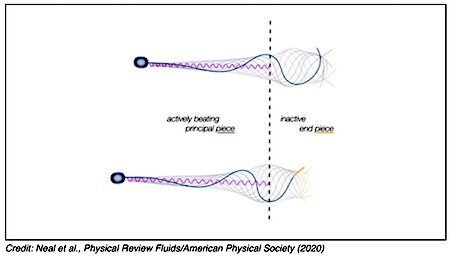Sperm Production: Appreciating a Piece of Tail
The far end of the tail of a human sperm has been studied scientifically a bit less than the other parts of the sperm’s structure. A new study suggests that this little chunk is a fairly important part of the sperm’s swimming mechanism.
“Doing more with less: The flagellar end piece enhances the propulsive effectiveness of human spermatozoa,” Cara V. Neal, Atticus L. Hall-McNair, Jackson Kirkman-Brown, David J. Smith, and Meurig T. Gallagher, Physical Review Fluids, epub 2020. The authors, at the University of Birmingham, UK, explain:
“Spermatozoa self-propel by propagating bending waves along a predominantly active elastic flagellum. The organized structure of the “9 + 2’’ axoneme is lost in the most-distal few microns of the flagellum, and therefore this region is unlikely to have the ability to generate active bending; as such it has been largely neglected in biophysical studies. Through elastohydrodynamic modeling of human-like sperm we show that an inactive distal region confers significant advantages, both in propulsive thrust and swimming efficiency, when compared with a fully active flagellum of the same total length.”

Marc Abrahams's Blog
- Marc Abrahams's profile
- 14 followers




